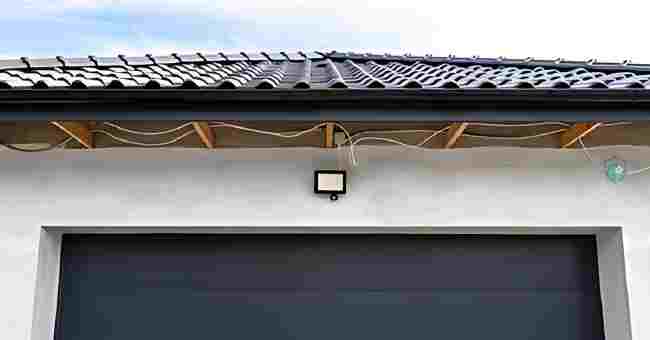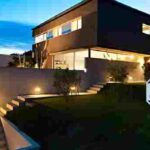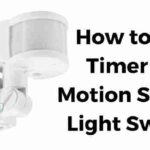Table of Contents
Do you wish to know how to properly set up and adjust your motion sensor light in your home or business? Yes, Installing a motion sensor light in your home or business provides a wealth of benefits when it comes to security, convenience and efficiency.
Isn’t it frustrating coming home at night, arms full of groceries, fumbling in the dark for your keys while trying to balance everything?
I remember the first night we moved into our new home, juggling boxes while trying to unlock the front door. If only the porch light had turned on automatically.
It wasn’t until I installed motion sensor lights that this pesky problem went away. Now the outdoor lights brighten our path the moment we pull into the driveway.
In this comprehensive guide, we’ll cover everything you need to know about maximizing the effectiveness of your motion activated lighting, from understanding the different components and settings to troubleshooting common problems.
Whether you’ve just installed new outdoor motion sensor lights or are trying to dial in your existing system, read on for expert tips and advice.
An Introduction to Motion Sensor Lights
Before we dive into the setup process, let’s review the basics of what exactly motion sensor lights are and how they work.
Motion sensor lights are lighting systems that automatically turn on when motion is detected in their range and field of view. They work via two main components:
- Sensor: The sensor detects motion, usually through passive infrared (PIR) technology that detects changes in heat signatures.
- Light Fixture: The light fixture illuminates the area when triggered by the motion sensor. Fixtures may be hardwired or battery-powered.
Additionally, most motion sensor lights have adjustable controls and settings to customize their operation, allowing you to fine tune things like detection range, activation duration and more.
The major benefits that make motion detecting lights so popular include:
- Hands-free illumination – Lights turn on automatically when you enter the area
- Energy efficiency – Lights are only on when needed as opposed to constantly
- Security – Sudden light can startle intruders and signal occupancy
- Flexibility – Sensitivity and duration settings can be customized
Now let’s go over the steps involved in the initial setup process.
How to Properly Set Up and Adjust Your Motion Sensor Light
Setting Up Your New Motion Sensor Light
The actual installation of a hardwired or plug-in motion sensor light fixture will vary depending on the specific model and location.
Always follow manufacturer instructions closely during physical installation.
That said, there are still some general guidelines and standard configuration steps to bear in mind:
Choose an Appropriate Location
Take into account the detection range of your particular motion sensor light model and the field of view you want to cover.
Also consider potential false trigger sources like tree branches or vegetation movement.
- Good locations: Entryways, garage doors, driveways, staircases
- Bad locations: Near trees/brush, facing windows, under eaves
Adjust the Mounting Angle
Most outdoor motion sensor lights can pivot and shift the aiming angle during mounting. Make sure it’s angled properly to fully cover the desired area.
Connect the Power Supply
If hardwired, connect wires securely with wire nuts: hot (black) wire, neutral (white) wire and ground (green) wire. If plug-in, simply insert plugin securely into outlet.
Adjust Lux Level
The lux level, or ambient light sensor threshold, determines at what ambient brightness the light will activate when it detects motion. Set it higher to prevent daytime activation.
Determine Sensitivity Level
Start with a lower sensitivity level and increase as needed. Too high may lead to false triggers.
With the hardware and wiring set up, it’s time to optimize the settings of your motion activated light.
Understanding Settings on Your Motion Sensor Lights
To work properly for your specific needs, the settings on your exterior motion activated light will need some fine tuning.
The main settings you’ll work with include:
- Sensitivity: Detection range and trigger threshold
- Time Delay: How long light stays on after detection
- Lux Level: Ambient brightness activation threshold
Let’s look at how each setting impacts performance and how to choose the right configuration.
Setting the Right Sensitivity Level
The sensitivity setting determines two main factors on motion sensor lights:
- Detection Range: More sensitivity means a larger motion detection range. Less sensitivity means a smaller range.
- Activation Threshold: More sensitivity leads to easier activation from smaller movements. Less sensitivity requires larger motion.
Why does proper sensitivity matter?
- Too high can increase false triggers
- Too low can mean missed motion activation
Guidelines for Choosing Sensitivity Level:
- High traffic areas: Higher sensitivity
- Infrequent traffic areas: Lower sensitivity
- Security lights: Higher sensitivity
Start with lower sensitivity and increase as needed. Evaluate performance over a few days and continue adjusting until the detection range and reliability meet your needs.
Configuring the Time Delay
The time delay setting determines how long the motion sensor security light stays illuminated after motion is detected before automatically turning back off.
This controls the duration of light so it’s important to choose carefully. Why?
- Short delays may turn off before task is done
- Long delays waste energy
Guidelines for Selecting Time Delay Duration:
- Light needed for short duration (hallways): 5-10 seconds
- Extended lighting tasks (backyard): 30-60 seconds
Similar to setting sensitivity level, start with a moderate time delay setting while evaluating the light over a few nights of usage before settling on the ideal duration.
Adjusting the Lux Level Threshold
The lux level setting controls the ambient light level at which the motion flood light will activate when it detects motion.
This prevents the light from turning on unnecessarily during daylight hours.
- Higher lux = Only activates in darker conditions
- Lower lux = Activates in lighter conditions
Aim for a higher lux level in most cases for increased energy efficiency, unless the light is needed at night and during dawn/dusk hours.
Now let’s move onto optimizing the detection performance…
Optimizing Motion Detection Reliability
Beyond choosing the right settings levels, the placement and positioning of your outdoor motion detector lights also impacts functionality.
Follow these tips for enhancing motion detection reliability:
Strategic Positioning Guidelines
- Face broad and open areas
- Keep clear line of sight
- Avoid facing windows
- Position 8-12 feet high
Avoid Problem Sources
- Swaying vegetation
- Wind and rain
- Extreme temperatures
- Sun glare and reflections
Consider an Additional Sensor
For large areas, use multiple motion sensing lights or sensors to cover more zones and eliminate blindspots. The extra sensor provides complete coverage.
Proper placement and positioning goes hand in hand with dialing in the right sensitivity and settings.
Now let’s go over some troubleshooting tips for common problems…
Troubleshooting Issues With Your Motion Sensor Lights
While motion sensor lights are very convenient when working properly, they can sometimes develop issues that affect their performance.
Here are some of the most common problems and how to get your motion activated lighting functioning correctly again:
Problem: The light isn’t turning on when motion is detected
- Solution: First, check if the light bulb has burned out and needs replacement. Also increase the sensitivity level. Ensure power supply and wiring connections are intact.
Problem: Light false triggers and turns on unexpectedly
- Solution: Decrease sensitivity level to prevent minor motions from activating light unnecessarily. Consider repositioning if light is facing problem source areas.
Problem: Light turns off before motion has ceased
- Solution: Extend the time delay setting to keep light on for longer duration after initial motion detection.
Problem: Light stays on constantly
- Solution: Check settings. Sensitivity may be too high and time delay inadvertently set to “Test” or indefinite-on mode. Reset to normal operation settings.
For continued reliability and maximized lifespan:
- Perform occasional wiring check
- Clean motion sensor lens
- Replace aging bulbs
- Have electrician inspect if problems persist
With the right troubleshooting and maintenance, your motion sensor security lights will perform reliably for years to come.
Going Beyond Security: Creative Uses for Motion Lights
While motion activated lights are most commonly used for security purposes as discussed above, there are also some creative ways to use them beyond illumination for safety:
Driveway Announcement Lights
Position a motion light facing the driveway to announce arriving vehicles and guests with a bright beam lighting up the entire entry path.
Pathway Luminaries
Line walkways with subtle modern motion lights that add flair and automatically light up to guide the way.
Stair Safety Lights
Strategically place motion spotlights facing indoor staircases to automatically activate safe visibility in the event of middle-of-the-night bathroom trips.
Automated Task Lighting
Install self-contained battery-powered motion lights under cabinets, shelves, workshops tables and more to free up both hands for cooking, tinkering, crafting and other hobbies.
Pet Area Illumination
Shed light on outdoor pet areas like kennels, enclosures and walking areas to improve visibility and safety for monitoring or late night leashed walks.
As you can see, with some creativity you can find all kinds of handy uses for motion sensor lights beyond standard security and safety applications.
Choosing the Right Motion Sensor Light Brands and Models
Now that you know what to look for in terms of features and how to optimize motion sensor light performance.
It’s also helpful to know which are some of the top brands and specific models on the market.
We recommend evaluating products from these leading outdoor motion sensor lighting manufacturers:
- Ring
- Lithonia Lighting
- Mr Beams
- LEONLITE
- Aspectek
When choosing a particular light, consider factors like:
- Detection range
- Lumens
- Size and shape
- Durability
- Smart connectivity
- Price
Compare features between models to find the right balance of functionality, cost and quality for your specific needs.
Here is a comparison table highlighting top-rated products across key factors:
| Product | Detection Range | Lumens | IP-Rating | WiFi-Enabled | Price |
|---|---|---|---|---|---|
| Ring Floodlight Cam | 30 feet | 3000 Lumens | IP55 | Yes | $249 |
| Lithonia Lighting Coach Light | 50 feet | 2100 Lumens | IP65 | No | $65 |
| Mr Beams LED Spotlight | 25 feet | 600 Lumens | IP44 | No | $36 |
| LEONLITE 180-degree Flood Light | 65 feet | 2300 Lumens | IP55 | No | $99 |
| Aspectek Dual Head Light | 20 feet | 3600 Lumens | IP44 | No | $50 |
This gives you an idea of the performance differences across budget levels. See our detailed motion sensor light reviews for more in-depth analysis and testing results.
We hope this guide has covered all the key information you need to successfully install your outdoor motion flood lights or other motion sensor fixtures.
The key is finding the right balance of settings like sensitivity, time delay and lux level for your specific needs.
Combined with optimal placement and reducing false trigger sources, you’ll have a motion-activated lighting solution that provides maximum security, energy efficiency and convenience for years to come.
FAQs
How Do Motion Sensor Lights Work?
Motion sensor lights work by using a motion detector sensor to detect movement in the surrounding area.
This sensor is typically a passive infrared (PIR) type that detects changes in infrared energy emitted from heat sources.
When a moving person or object is detected by the sensor, it triggers the activation of the light fixture to turn on.
Many lights also have an ambient light sensor or light level sensor that prevents the light from activating in bright daytime light.
The main components that make up a motion activated light are the motion detector sensor, light fixture, and control box with settings adjustments.
What Is The Detection Range Of Most Models?
The detection range, or detection distance, refers to the circular area within which a motion sensor security light can detect movement and activate.
Most home outdoor models have detection ranges between 20 to 50 feet. Larger, more powerful floodlights may reach out to 70+ feet.
The range also depends on sensitivity settings. Higher sensitivity allows for a longer detection reach, while lower sensitivity reduces the range.
Consider your desired coverage area when selecting and positioning your light.
How Do You Change The Sensitivity On A Motion Sensor Light?
The sensitivity setting controls how easily movement triggers activation of the motion sensing outdoor light.
Adjustments are made via a sensitivity control dial or buttons on the back of the light fixture or its control box.
If your motion detector light keeps turning on unexpectedly, lower the sensitivity. If the light fails to activate when motion is present, increase the sensitivity level.
Start low and gradually increase until you find the sweet spot of reliable motion activation within your desired range.
Where Is The Best Place To Install Exterior Motion Sensor Lighting?
Ideally, install your outdoor motion light facing open areas of your property with a clear line of sight. Position on a wall or eave 8-12 feet above ground level.
Avoid positioning directly under roof overhangs or facing trees, shrubs and solid walls that can obstruct motion detection and even trigger false activations.
Also aim away from reflective surfaces like windows that can confuse the sensor. Position it to maximize your intended coverage area.
How Do You Make A Motion Sensor Light Stay On Longer?
To make your motion activated light stay illuminated longer after motion is detected, look for the time or duration adjustment settings.
This setting may be labeled delay, hold time or duration. Simply increase the duration time to keep the light on for a longer period after the initial motion trigger.
Duration lengths typically range from 10 seconds to 10 minutes. Just take care not to set it too long if not necessary as that wastes electricity. Start with 30-60 seconds and adjust from there.
Why Does My Motion Light Come On For No Reason?
If your outdoor motion sensor light is activating unexpectedly with no movement occurring, this false triggering is typically caused by overly sensitive detection settings.
Nearby trees blowing in the wind, small animals moving through the yard, passing cars or even lighting changes can accidentally switch the light on.
If you experience frequent false triggers, adjust down the sensitivity level incrementally until the random activations stop.
Also make sure the light isn’t positioned too close to problem sources of accidental motion detection.
How Can I Stop My Motion Sensor Light From Flickering?
If your motion detecting security light exhibits flickering behavior, where the illumination appears unstable and inconsistent, the likely culprits are a faulty bulb, loose wiring connections or electrical supply issues.
First replace the bulb with an equivalent new one recommended by the manufacturer.
Next, check wiring terminations are properly secured with no exposed copper. Finally, electrical fluctuations may require installing a surge protector to regulate anomalous voltage spikes.
If issues persist, have an electrician inspect and further troubleshoot your motion activated flood light.
What Makes A Motion Sensor Light Waterproof?
To qualify as waterproof, a motion sensor exterior light must have a minimum ingress protection (IP) rating of IPX4 according to international standards.
This means the fixture resists splashing water from all directions with no harmful effects.
Models rated IPX5 or IPX6 can withstand more powerful water jets. For lights exposed to the sprinklers or weather, select one with an IP44, IP55 or IP65 rating to ensure waterproof protection for long-lasting performance.
The higher the number, the better the water resistance.
How Can I Improve The Lifespan Of My Motion Sensor Light Bulb?
To maximize lifespan of the light bulb or lamp in your motion sensor porch light, follow these tips:
- Choose LED bulbs over less durable incandescent varieties
- Look for energy efficient, long-life bulbs rated for at least 25,000 hours
- Make sure selected wattage, type, beam angle and lumen output matches manufacturer recommendations
- Install bulb properly to avoid electrical shorts from bad connections
- Avoid excessive cycling by configuring time delay and sensitivity settings judiciously With careful operation and the right bulb, your motion activated light bulb should only need infrequent replacements, saving you money.
Conclusion
We’ve covered a lot of ground when it comes to properly configuring your motion sensor fixtures.
Always remind your light’s sensitivity and delay durations, strategically place for optimal coverage, and troubleshoot issues like false triggers.
Properly installing motion detection lighting prevents darkened doorway fumbling. Here’s to bright, automated illumination.





Pingback: Heath Zenith Motion Sensor Light Troubleshooting: Fix It Fast -